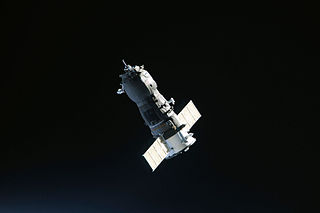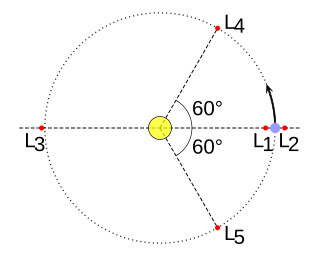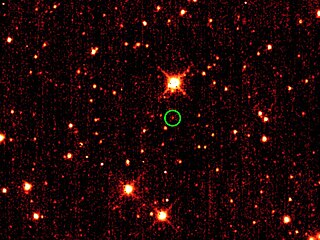
In celestial mechanics, the Lagrangian points are the points near two large bodies in orbit where a smaller object will maintain its position relative to the large orbiting bodies. At other locations, a small object would go into its own orbit around one of the large bodies, but at the Lagrangian points the gravitational forces of the two large bodies, the centripetal force of orbital motion, and the Coriolis acceleration all match up in a way that cause the small object to maintain a stable or nearly stable position relative to the large bodies.

The Jupiter trojans, commonly called Trojan asteroids or simply Trojans, are a large group of asteroids that share the planet Jupiter's orbit around the Sun. Relative to Jupiter, each Trojan librates around one of Jupiter's two stable Lagrange points: L4, lying 60° ahead of the planet in its orbit, and L5, 60° behind. Jupiter trojans are distributed in two elongated, curved regions around these Lagrangian points with an average semi-major axis of about 5.2 AU.

Ulysses is a decommissioned robotic space probe whose primary mission was to orbit the Sun and study it at all latitudes. It was launched in 1990 and made three "fast latitude scans" of the Sun in 1994/1995, 2000/2001, and 2007/2008. In addition, the probe studied several comets. Ulysses was a joint venture of NASA and the European Space Agency (ESA) with participation from Canada's National Research Council. The last day for mission operations on Ulysses was June 30, 2009.

Uncrewed or unmanned spacecraft are spacecraft without people on board, used for robotic spaceflight. Uncrewed spacecraft may have varying levels of autonomy from human input; they may be remote controlled, remote guided or even autonomous, meaning they have a pre-programmed list of operations, which they will execute unless otherwise instructed.

The Interplanetary Transport Network (ITN) is a collection of gravitationally determined pathways through the Solar System that require very little energy for an object to follow. The ITN makes particular use of Lagrange points as locations where trajectories through space can be redirected using little or no energy. These points have the peculiar property of allowing objects to orbit around them, despite lacking an object to orbit. While it would use little energy, transport along the network would take a long time.
In astrodynamics, the orbital maneuvers made by thruster burns that are needed to keep a spacecraft in a particular assigned orbit are called orbital station-keeping.

The Herschel Space Observatory was a space observatory built and operated by the European Space Agency (ESA). It was active from 2009 to 2013, and was the largest infrared telescope ever launched, carrying a 3.5-metre (11.5 ft) mirror and instruments sensitive to the far infrared and submillimetre wavebands (55–672 µm). Herschel was the fourth and final cornerstone mission in the Horizon 2000 programme, following SOHO/Cluster II, XMM-Newton and Rosetta. NASA is a partner in the Herschel mission, with US participants contributing to the mission; providing mission-enabling instrument technology and sponsoring the NASA Herschel Science Center (NHSC) at the Infrared Processing and Analysis Center and the Herschel Data Search at the Infrared Science Archive.

Kordylewski clouds are large concentrations of dust that exist at the L4 and L5 Lagrangian points of the Earth–Moon system. They were first reported by Polish astronomer Kazimierz Kordylewski in the 1960s, and confirmed to exist in October 2018.

In astronomy, a trojan is a small celestial body that shares the orbit of a larger one, remaining in a stable orbit approximately 60° ahead or behind the main body near one of its Lagrangian points L4 and L5. Trojans can share the orbits of planets or of large moons.

A space probe is a robotic spacecraft that does not orbit Earth, but instead, explores further into outer space. A space probe may approach the Moon; travel through interplanetary space; flyby, orbit, or land on other planetary bodies; or enter interstellar space.

In orbital mechanics, a Lissajous orbit, named after Jules Antoine Lissajous, is a quasi-periodic orbital trajectory that an object can follow around a Lagrangian point of a three-body system without requiring any propulsion. Lyapunov orbits around a Lagrangian point are curved paths that lie entirely in the plane of the two primary bodies. In contrast, Lissajous orbits include components in this plane and perpendicular to it, and follow a Lissajous curve. Halo orbits also include components perpendicular to the plane, but they are periodic, while Lissajous orbits are not.

A halo orbit is a periodic, three-dimensional orbit near one of the L1, L2 or L3 Lagrange points in the three-body problem of orbital mechanics. Although a Lagrange point is just a point in empty space, its peculiar characteristic is that it can be orbited. Halo orbits can be thought of as resulting from an interaction between the gravitational pull of the two planetary bodies and the Coriolis and centripetal acceleration on a spacecraft. Halo orbits exist in any three-body system, e.g., the Sun–Earth–Orbiting Satellite system or the Earth–Moon–Orbiting Satellite system. Continuous "families" of both Northern and Southern halo orbits exist at each Lagrange point. Because halo orbits tend to be unstable, stationkeeping is required to keep a satellite on the orbit.

An Earth trojan is an asteroid that orbits the Sun in the vicinity of the Earth–Sun Lagrangian points L4 (leading 60°) or L5 (trailing 60°), thus having an orbit similar to Earth's. Only one Earth trojan has so far been discovered. The name trojan was first used in 1906 for the Jupiter trojans, the asteroids that were observed near the Lagrangian points of Jupiter's orbit.

2010 TK7 is a sub-kilometer near-Earth asteroid and the first (and only) Earth trojan discovered to date; it precedes Earth in its orbit around the Sun. Trojan objects are most easily conceived as orbiting at a Lagrangian point, a dynamically stable location (where the combined gravitational force acts through the Sun's and Earth's barycenter) 60 degrees ahead of or behind a massive orbiting body, in a type of 1:1 orbital resonance. In reality, they oscillate around such a point. Such objects had previously been observed in the orbits of Mars, Jupiter, Neptune, and the Saturnian moons Tethys and Dione.

The Near-Earth Object Surveillance Mission (NEOSM), formerly called Near-Earth Object Camera (NEOCam) is a planned space-based infrared telescope designed to survey the Solar System for potentially hazardous asteroids.

Lucy is a planned NASA space probe that will tour five Jupiter trojans, asteroids which share Jupiter's orbit around the Sun, orbiting either ahead of or behind the planet and one main belt asteroid. All target encounters will be fly-by encounters.
EQUULEUS is a nanosatellite of the 6-Unit CubeSat format that will measure the distribution of plasma that surrounds the Earth (plasmasphere) to help scientists understand the radiation environment in that region. It will also demonstrate low-thrust trajectory control techniques, such as multiple lunar flybys, within the Earth-Moon region using water steam as propellant. The spacecraft was designed and developed jointly by the Japan Aerospace Exploration Agency (JAXA) and the University of Tokyo.
Lagrange is a 2018 concept study for a solar weather mission by the European Space Agency (ESA). This is a British-led concept that envisions two spacecraft to be positioned at Lagrangian points L1 and L5.


















